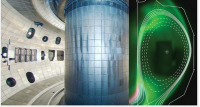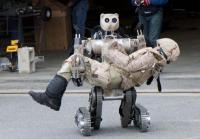-
Concrete innovation makes Seattle skyscraper stable
All coupling beams in the 1.5 million-square-foot Lincoln Square Expansion — which includes luxury condos, a hotel, dining, retail and office space in two 450-foot towers in the heart of Seattle suburb Bellevue, Washington — are made of fiber-reinforced concrete using a unique design. These concrete coupling beams span doorways and windows, helping walls with such openings in them to function as a single structural unit, while bolstering the building as a whole against earthquakes. Traditionally, coupling beams are reinforced with a labyrinth of rebar, adding a great deal of time, cost and complexity to the construction process.
-
-
Steam thermography may compete with luminol in solving crimes
Luminol gets trotted out pretty frequently on TV crime shows, but a new technique might someday compete with the storied forensics tool as a police procedural plot device and, perhaps more importantly, as a means of solving real crimes. Researchers developed what they term “steam thermography,” which has the ability to detect blood spots in all kinds of spots — even in spots where luminol cannot.
-
-
Technology confronts disasters
In 2010, soon after Haiti was devastated by an earthquake, a team from MIT Lincoln Laboratory collected and analyzed information to help the U.S. Southern Command (USSOUTHCOM), the lead military agency responding to the crisis, effectively dispatch vital resources, including food, water, tents, and medical supplies, to the victims of this disaster. This Haiti experience demonstrated to Lincoln Laboratory researchers that advanced technology and technical expertise developed for the Department of Defense (DoD) can significantly benefit future humanitarian assistance and disaster relief efforts. In February, the Laboratory established the Humanitarian Assistance and Disaster Relief (HADR) Systems Group to explore ways to leverage or advance existing capabilities for improving disaster responses.
-
-
Developing nuclear cladding to withstand Fukushima-like meltdown conditions
Like much of the rest of the world, thousands of scientists and engineers watched in March 2011 as Japan’s Fukushima Daiichi nuclear reactors exploded. The fuel’s cladding, a zirconium alloy used to contain the fuel and radioactive fission products, reacted with boiling coolant water to form hydrogen gas, which then exploded, resulting in the biggest nuclear power-related disaster since Chernobyl. Challenged by this event, two research teams have made progress in developing fuel claddings that are capable of withstanding the high temperatures resulting from a Loss of Coolant Accident (LOCA), like that at Fukushima.
-
-
Airborne networking capabilities for hostile environments
Modern airborne warfare is becoming increasingly complex, with manned and unmanned systems having rapidly to share information in a volatile environment where adversaries use advanced, commercially available electronic systems to disrupt U.S. and allied communications. DARPA’s Dynamic Network Adaptation for Mission Optimization (DyNAMO) program. DyNAMO seeks novel technologies which would enable independently designed networks to share information and adapt to sporadic jamming and mission-critical dynamic network bursts in contested RF environments.
-
-
Improving precision of drone navigation

Researchers are working to bring a new level of precision to the navigation systems used to guide drones. The work is supported through a contract with Southern Company, one of the U.S. largest energy companies, which plans to use unmanned aircraft to enhance safety for crews in the field and improve reliability for customers. The researchers have designed a prototype which uses onboard ultrasound sensors to relay information on the aircraft’s location to its operator.
-
-
Instant water heater offers energy, cost savings
Traditional water heaters take time to reach preferred temperatures, thus wasting water and energy. A new instant hot water solution, developed through the EU-funded RAPIDHEAT project, successfully optimized heating and control technologies to develop a lightweight low thermal mass heater that provides full temperature output within two seconds of switch-on.
-
-
An app alerts people, law enforcement about potential crime risk
You are walking home after a night out on a dark autumn evening. Suddenly, you get the feeling that someone is following you. You look over your shoulder, and see a shadow between the trees in the park. You quicken your steps. When you glance behind you again, you see the shadow disappear in between two houses. This is when you could press the “help” button on the app that you have downloaded. It sends a message to everyone in the area who also has the app, with information about your phone number and where you are. This way they are able to call you, alert emergency services, or get to your location if need be. The app has been developed by a group of student entrepreneurs.
-
-
New flame retardant is naturally derived, nontoxic
Flame retardants are added to foams found in mattresses, sofas, car upholstery, and many other consumer products. Once incorporated into foam, these chemicals can migrate out of the products over time, releasing toxic substances into the air and environment. Inspired by a naturally occurring material found in marine mussels, researchers have created a new flame retardant to replace commercial additives that are often toxic and can accumulate over time in the environment and living animals, including humans.
-
-
Recovering rare earth materials from electric and hybrid vehicle motors
China currently supplies about 97 percent of rare earth materials used in manufacturing around the world. In an effort to help develop a sustainable domestic supply of rare earth elements and lessen the U.S. dependence on China for materials that are vital to the production of electronics, wind turbines, and many other technologies, researchers have developed a method of extracting rare earths from the drive units and motors of discarded electric and hybrid cars.
-
-
Clothing that guards against chemical warfare agents
Recent reports of chemical weapons attacks in the Middle East underscore the need for new ways to guard against their toxic effects. Scientists report that a new hydrogel coating that neutralizes both mustard gas and nerve agent VX. It could someday be applied to materials such as clothing and paint.
-
-
DHS recruits Silicon Valley entrepreneurs to develop first-response technology
DHS wants better technology for first responders — police, firefighters, and EMTs — but rather than pushing for innovation from within the massive corporations that already provide technology to government agencies, the DHS has come to Silicon Valley to tap the entrepreneurial ecosystem of northern California. Giant technology firms have resources of large scale manufacturing and distribution, but there is one crucial difference. Technology startups are much more nimble, and can shift their development much faster than the huge corporations can.
-
-
Small-scale nuclear fusion may be a new energy source

Nuclear fusion is a process whereby atomic nuclei melt together and release energy. Because of the low binding energy of the tiny atomic nuclei, energy can be released by combining two small nuclei with a heavier one. Fusion energy may soon be used in small-scale power stations. This means producing environmentally friendly heating and electricity at a low cost from fuel found in water. Both heating generators and generators for electricity could be developed within a few years, according to researchers.
-
-
Robots to pull wounded soldiers off battlefield

Most Americans have seen at least one war movie, where at some point a fresh-faced young private is hit with some shrapnel. From the ground, he calls out for the unit medic — another young guy, from another small town, whose quick reaction and skill just may save his life. In the near future, however, it may no longer be another soldier, who comes running to his side. Instead, it might be an Army-operated unmanned aerial or ground vehicle.
-
-
Testing radiation detection systems in harsh conditions
Researchers from five laboratories and a private company recently spent two days in blistering 100 degree heat testing radiation detection technologies amidst cargo containers. The fifteen researchers demonstrated the feasibility of using gamma-ray and neutron imaging detectors to identify radioactive materials using the Lawrence Livermore National Laboratory’s (LLNL) cargo container stack testbed.
-
More headlines
The long view
New Technology is Keeping the Skies Safe
DHS S&T Baggage, Cargo, and People Screening (BCP) Program develops state-of-the-art screening solutions to help secure airspace, communities, and borders
Factories First: Winning the Drone War Before It Starts
Wars are won by factories before they are won on the battlefield,Martin C. Feldmann writes, noting that the United States lacks the manufacturing depth for the coming drone age. Rectifying this situation “will take far more than procurement tweaks,” Feldmann writes. “It demands a national-level, wartime-scale industrial mobilization.”
How Artificial General Intelligence Could Affect the Rise and Fall of Nations
By Barry Pavel et al.
Visions for potential AGI futures: A new report from RAND aims to stimulate thinking among policymakers about possible impacts of the development of artificial general intelligence (AGI) on geopolitics and the world order.
Keeping the Lights on with Nuclear Waste: Radiochemistry Transforms Nuclear Waste into Strategic Materials
By John Domol
How UNLV radiochemistry is pioneering the future of energy in the Southwest by salvaging strategic materials from nuclear dumps –and making it safe.
Model Predicts Long-Term Effects of Nuclear Waste on Underground Disposal Systems
By Zach Winn
The simulations matched results from an underground lab experiment in Switzerland, suggesting modeling could be used to validate the safety of nuclear disposal sites.
